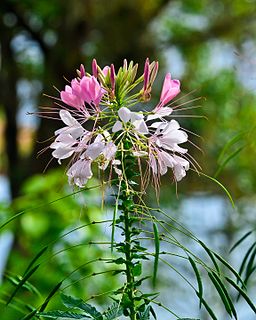
Abuta is a genus in the flowering plant family Menispermaceae, of about 32 species, native to tropical Central and South America.

August Wilhelm Eichler, also known under his Latinized name, Augustus Guilielmus Eichler, was a German botanist who developed a new system of classification of plants to reflect the concept of evolution. His author abbreviation in botany is Eichler.

Cleome is a genus of flowering plants in the family Cleomaceae, commonly known as spider flowers, spider plants, spider weeds, or bee plants. Previously, it had been placed in the family Capparaceae, until DNA studies found the Cleomaceae genera to be more closely related to the Brassicaceae than the Capparaceae. Cleome and clammyweed, can sometimes be confused. The simplest way to differentiate the two is to compare the seedpods which project out or down on cleome and up on clammyweed.
Acanthosyris is a genus of plants in the family Santalaceae. It contains the following species:
- Acanthosyris annonagustataC.Ulloa & P.M.Jørg.
- Acanthosyris asipapoteM.Nee
- Acanthosyris falcataGriseb.
- Acanthosyris glabrata(Stapf) Stauffer ex Govaerts
- Acanthosyris paulo-alviniiG.M.Barroso
- Acanthosyris spinescens(Mart. & Eichler) Griseb.

Picramnia, the bitterbushes, is a genus of plant considered to be in the family Picramniaceae, but sometimes placed in Simaroubaceae. The name is conserved against the genera Pseudo-brasiliumAdans., and TaririAubl., both which have been rejected.

Salacia is a genus of plants in the family Celastraceae. They are woody climbers naturally found in tropical regions.

Floral diagram is a graphic representation of flower structure. It shows the number of floral organs, their arrangement and fusion. Different parts of the flower are represented by their respective symbols. Floral diagrams are useful for flower identification or can help in understanding angiosperm evolution. They were introduced in the late 19th century and are generally attributed to A. W. Eichler.

Amaro Macedo was a Brazilian botanist who was the best-known collector of the Brazilian Cerrado plant species of the 20th century. He lived in Ituiutaba, State of Minas Gerais, Brazil. He started his collection in 1943 when he was a teacher of Natural Sciences in the Instituto Marden, Ituiutaba. He collected most of his plant material in the cerrado vegetation of the States of Minas Gerais, Goiás, Maranhão and Pará. He collected also in the regions of the villages of Natividade, Porto Nacional and Filadelfia, at the time part of the State of Goiás, although now part of the state of Tocantins. Plant specimens from his collection are in several herbaria in Brazil and outside. Between 1943 and 2007 he collected 6,008 plant specimens, several of them are considered new species and some were dedicated to him by famous Botanists.
In mathematics, Eichler cohomology is a cohomology theory for Fuchsian groups, introduced by Eichler (1957), that is a variation of group cohomology analogous to the image of the cohomology with compact support in the ordinary cohomology group. The Eichler–Shimura isomorphism, introduced by Eichler for complex cohomology and by Shimura (1959) for real cohomology, is an isomorphism between an Eichler cohomology group and a space of cusp forms. There are several variations of the Eichler–Shimura isomorphism, because one can use either real or complex coefficients, and can also use either Eichler cohomology or ordinary group cohomology as in. There is also a variation of the Eichler–Shimura isomorphisms using l-adic cohomology instead of real cohomology, which relates the coefficients of cusp forms to eigenvalues of Frobenius acting on these groups. Deligne (1971) used this to reduce the Ramanujan conjecture to the Weil conjectures that he later proved.

Parasites tend to be highly specific to their hosts, thus it seems reasonable to expect a positive co-variation between the taxonomic richness of hosts and that of their parasites. Wolfdietrich Eichler (1912–1994), a German authority in zoology and parasitology was the first to point out this relationship in 1942 and it was later dubbed 'Eichler’s rule'. It is one of the first three coevolutionary rules.
Phthirusa pyrifolia is a subtropical flowering plant species of the family Loranthaceae. It grows in forests from Mexico through Central America, Peru, Bolivia, and Brazil. It flowers and fruits year-round; its small berries range in color from orange to deep red when ripe.
Ecclinusa is a genus of plants in the family Sapotaceae described as a genus in 1839.
Klaus Kubitzki is a German botanist. He is an Emeritus professor in the University of Hamburg, at the Herbarium Hamburgense. He is known for his work on the systematics and biogeography of the angiosperms, particularly those of the Neotropics, and also the floristic record of the Tertiary era. His plant systematic work is referred to as the Kubitzki system. He is a member of the American Society of Plant Taxonomists.

Doliocarpus is a genus of flowering plants in the family Dilleniaceae, native to Central and South America.

Carpotroche is a genus of shrubs and trees in the family Achariaceae. It is native to the American tropics.
Job Kuijt, is a Canadian botanist, with particular interest in Viscaceae, Loranthaceae and Eremolepidaceae










